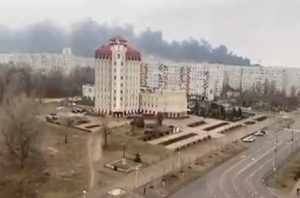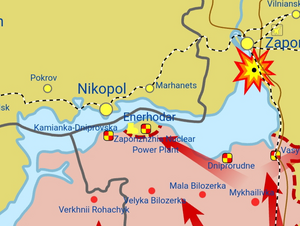
Zaporizhzhia Oblast, commonly referred to as Zaporizhzhia (Запоріжжя), is an oblast (region) in south-east Ukraine. Its administrative centre is Zaporizhzhia. The oblast covers an area of 27,183 square kilometres (10,495 sq mi), and has a population of 1,638,462.
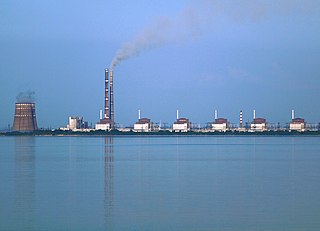
The Zaporizhzhia Nuclear Power Station in southeastern Ukraine is the largest nuclear power plant in Europe and among the 10 largest in the world. It has been under Russian control since 2022. It was built by the Soviet Union near the city of Enerhodar, on the southern shore of the Kakhovka Reservoir on the Dnieper river. From 1996 to 2022, it was operated by Energoatom, which operates Ukraine's other three nuclear power stations.

Zaporizhzhia, formerly known as Oleksandrivsk until 1921, is a city in southeast Ukraine, situated on the banks of the Dnieper River. It is the administrative centre of Zaporizhzhia Oblast. Zaporizhzhia has a population of 710,052.

The Rivne Nuclear Power Plant, also called Rovno is a nuclear power plant in Varash, Rivne Oblast, Ukraine.
State Enterprise National Nuclear Energy Generating Company "Energoatom", commonly known as just Energoatom, is a state enterprise operating all four nuclear power plants in Ukraine. It is the largest power producer in Ukraine.
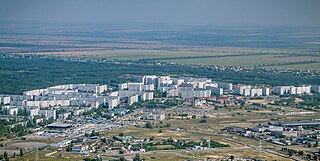
Enerhodar is a city and municipality in the northwest of Zaporizhzhia Oblast, Ukraine. It is on the south bank of the Dnieper River, on the opposite side of the Kakhovka Reservoir from Nikopol and Chervonohryhorivka.

Zaporizhzhia thermal power station is a large thermal power plant (DRES) in the purpose-built city of Enerhodar in Ukraine. It is the most powerful thermal power station in Ukraine, with an installed capacity of 2,850 MWe. Its primary fuel is coal. It can also fire natural gas and fuel oil, and has tank storage for these reserve fuels adjacent to the coal bunkers.

Ukraine operates four nuclear power plants with 15 reactors located in Volhynia and South Ukraine. The total installed nuclear power capacity is over 13 GWe, ranking 7th in the world in 2020. Energoatom, a Ukrainian state enterprise, operates all four active nuclear power stations in Ukraine. In 2019, nuclear power supplied over 20% of Ukraine's energy.
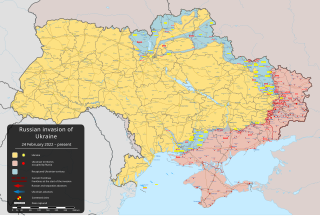
On 24 February 2022, Russia invaded Ukraine in a major escalation of the Russo-Ukrainian War, which started in 2014. The invasion, the largest conflict in Europe since World War II, has caused hundreds of thousands of military casualties and tens of thousands of Ukrainian civilian casualties. As of 2024, Russian troops occupy about 20% of Ukraine. From a population of 41 million, about 8 million Ukrainians had been internally displaced and more than 8.2 million had fled the country by April 2023, creating Europe's largest refugee crisis since World War II.

During the Russian invasion of Ukraine, the Chernobyl Exclusion Zone was captured on 24 February, the first day of the invasion, by the Russian Armed Forces, who entered Ukrainian territory from neighbouring Belarus and seized the entire area of the Chernobyl Nuclear Power Plant by the end of that day. On 7 March, it was reported that around 300 people were trapped and had been unable to leave the power plant since its capture. On 31 March, it was reported that most of the Russian troops occupying the area had withdrawn, as the Russian military abandoned the Kyiv offensive to focus on operations in Eastern Ukraine.

The southern Ukraine campaign is an ongoing theatre of operation in the Russian invasion of Ukraine, which began on 24 February 2022. The Russian military invaded Kherson Oblast in southern Ukraine from Russian-occupied Crimea, quickly entering Mykolaiv Oblast and Zaporizhzhia Oblast amid battles with the Armed Forces of Ukraine.
A military engagement took place between the Armed Forces of Ukraine and the Armed Forces of Russia in the city of Melitopol, Zaporizhzhia Oblast, on the southern front of the Russian invasion of Ukraine. Russian forces entered the city on 25 February and took control of its government buildings.
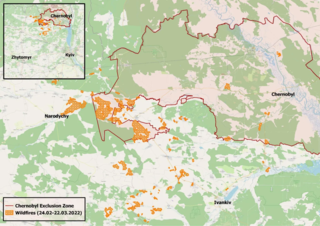
Ukraine is home to four nuclear power plants, as well as the Chernobyl Exclusion Zone, site of the 1986 Chernobyl disaster. As of January 2024, both the Chernobyl and the Zaporizhzhia nuclear power plants saw battles during the war that resulted from the 2022 Russian invasion of Ukraine. The invasion has prompted significant discussion about the status of the power plants, including fears of potential disasters, and has also prompted debates about nuclear energy programmes in other European countries.
During the Russian invasion of Ukraine and the resulting Russian occupation of multiple Ukrainian towns and cities, numerous cases of non-violent resistance against the invasion took place. Local residents organised protests against the invasion and blocked the movement of Russian military equipment. The Russian military dispersed the protests, sometimes with live fire, injuring many and killing some. Most of the large protests ended in March.
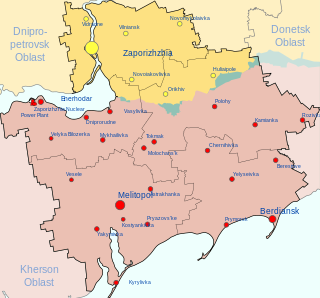
The ongoing military occupation of Ukraine's Zaporizhzhia Oblast by Russian forces began on 24 February 2022 during the Russian invasion of Ukraine as part of the southern Ukraine campaign. It was administrated under a Russian-controlled military-civilian administration until 30 September 2022, when it was illegally annexed to become an unrecognized federal subject of Russia.

During the Russian invasion of Ukraine, the Zaporizhzhia Nuclear Power Plant has become the center of an ongoing nuclear safety crisis, described by Ukraine as an act of nuclear terrorism by Russia.
During the Russian invasion of Ukraine, several senior Russian politicians, including president Vladimir Putin, former president and prime minister Dmitry Medvedev, and foreign minister Sergey Lavrov, have made a number of statements widely seen as nuclear blackmail. The possibility of Russia using tactical nuclear weapons, and the risk of broader nuclear escalation, has been widely discussed by commentators and in the media. By 2024, many of the Russian government's "red lines" had been crossed without nuclear weapons being used in response. As well as nuclear weapons threats, the Russian occupation of the Zaporizhzhia Nuclear Power Plant has led to a crisis over the safety of the plant and the risk of a nuclear disaster.
This timeline of the Russian invasion of Ukraine covers the period from 24 February 2022, when Russia launched a military invasion of Ukraine, to 7 April 2022 when fighting focused away from the north and towards the south and east of Ukraine.
Following the Russian invasion of Ukraine on 24 February 2022, the Ukrainian city of Zaporizhzhia and the surrounding region became the target of repeated Russian shelling and bombing as part of the southern Ukraine offensive from 27 February 2022 onwards. Thirty to forty percent of the infrastructure in the city has been destroyed.
